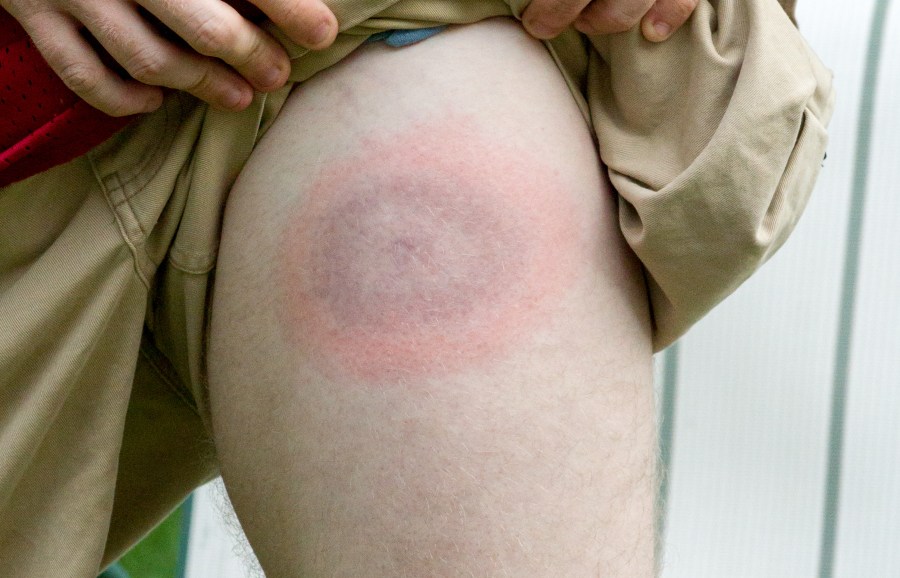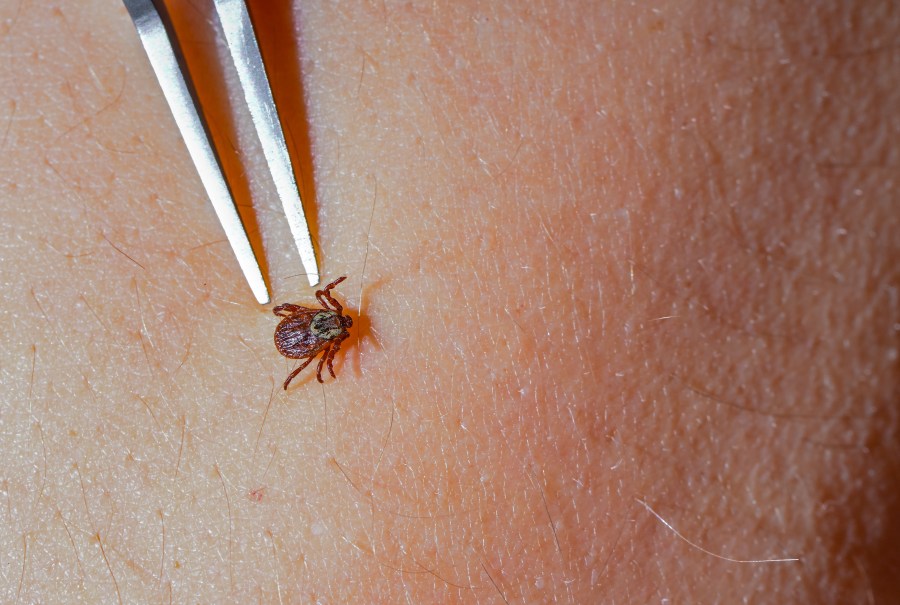Lyme disease: What you need to know
- Infected ticks, mostly in northern forests, spread Lyme disease
- Antibiotics clear up most cases in 2-4 weeks
- Always use tweezers, not fingers, to remove ticks

Woman hiking in Infected ticks forest with warning sign. Risk of tick-borne and lyme disease.
Testing on staging11
(NewsNation) —The barbecues, boating and baseball of summer are in full bloom — along with sunburn, poison ivy and a whole host of other natural dangers, including the bacterial infection known as Lyme disease.
Here’s a primer on what it is, what it can do to you, how to prevent it and how to treat it.
What is Lyme disease?
It’s a bacterial infection — an illness caused by bacteria or other toxins entering the body and multiplying. Strep throat, E. coli, salmonella and impetigo are among the most common of these. While they share many symptoms with viral infections, bacterial infections don’t always cause disease.
How does Lyme disease spread?
Infected ticks are the culprit in North America. Infected blacklegged ticks most commonly inhabit the forests of the northeastern, north central and mid-Atlantic states, and in smaller areas within Pacific Coast states.
Ticks get infected by feeding on the blood of rodents. They pass it on when they latch on to another animal, including humans. While deer are an important source of blood and transportation for ticks, deer don’t become infected with Lyme disease, and they don’t infect ticks. It usually takes about 24 hours for a tick to spread Lyme disease to a human.
Dogs can get Lyme disease, but they don’t pass it directly to humans. But your dog could bring infected ticks into your home, so it’s wise to consider anti-tick medication. Cats, on the other hand, are believed to be highly resistant to Lyme disease.
How do I know it’s Lyme disease?
It could take several weeks after you’re bitten by an infected tick for your immune system to make enough antibodies to show up on a test. In the meantime, talk to your doctor about the likelihood that you’ve been infected by blacklegged ticks.
What are the symptoms?
Untreated Lyme disease can produce a wide range of symptoms, depending on the stage of infection. Early symptoms may include fever, chills, headache, fatigue, muscle aches and swollen lymph nodes.
Nearly eight in 10 people will get a rash that will begin at the site of the tick bite, then spread out over a few days, sometimes in a bull’s-eye pattern as large as one foot in diameter.

The longer untreated Lyme disease goes, the worse the symptoms, including severe headaches, more rashes, facial palsy, occasional muscle and joint pain, heart palpitations, irregular heartbeat, dizziness, nerve pain, shooting pains and inflammation of the brain and spinal cord.
What’s the treatment?
Antibiotics in pill form usually do the trick in two to four weeks. But as many as 10% of people who get Lyme disease will suffer long-term symptoms including fatigue, body aches or foggy brain.
In those cases, antibiotics are not the treatment. In research, long-term antibiotics have shown to be no more effective than placebos. And they can lead to more serious complications including sepsis.
Some long-term sufferers have found help in the treatments developed for people suffering from chronic fatigue syndrome.
One caveat, though.:Fatigue, body aches and difficulty thinking can be caused by many other things, including infections, drugs, diabetes, depression and cancer.
What’s a co-infection?
That tick that bit you may have been carrying more than just Lyme disease. Blacklegged ticks can spread other diseases with the same bite — what’s called a co-infection.
The most common co-infection with Lyme disease is anaplasmosis, which occurs in up to 10% of patients with Lyme disease. Other co-infections, including babesiosis, Powassan virus disease, and hard tick relapsing fever, occur less frequently.
What are some Lyme disease myths?
You will not get Lyme disease through intimate human contact. The Lyme disease spirochete doesn’t work that way.
You won’t give your newborn baby Lyme disease via breast milk. It is extremely rare for a pregnant woman to pass the disease to her fetus.
There are no cases of Lyme disease spread by blood transfusion, even though the disease can live in blood that’s stored for transfusion.
You won’t get Lyme disease by eating game. But hunting in the forest may bring you close to those ticks.
There is no credible evidence that Lyme disease bacteria can be transmitted through air, food, water, or from the bites of mosquitoes, flies, fleas or lice.
How do I prevent getting Lyme disease?
Ticks live in shady, moist areas at ground level, but will cling to brush, lawns, shrubs and grass that are a few inches off the ground. They can’t jump or fly, and do not drop onto passing people or animals. They get on humans and animals only by direct contact. Once a tick gets on the skin, it generally climbs upward until it reaches a protected area.
If you garden, hike, camp, hunt, work or otherwise spend time in the outdoors, you can still protect yourself:
- Wear light-colored clothing with a tight weave to spot ticks easily.
- Wear enclosed shoes, long pants and a long-sleeved shirt.
- Tuck pant legs into socks or boots and shirt into pants.
- Check clothes and any exposed skin frequently for ticks.
- Consider using insect repellent.
- Stay on cleared, well-traveled trails. Avoid contacting vegetation.
- Avoid sitting directly on the ground or on stone walls.
- Keep long hair tied back, especially when gardening.
Also, a pill to prevent Lyme disease may be on the way. A California pharmaceutical company is still testing the pill, but if approved by the Food and Drug Administration, it would be the first medication to prevent Lyme disease and other tick-borne illnesses in humans.

If I find a tick on my skin, what next?
There are important “dos” and “don’ts” when it comes to tick removal.
DO:
- Use tweezers to grasp the tick as close to the skin as possible.
- Gently pull the tick in a steady, upward motion.
- Wash the area with disinfectant.
DON’T:
- Touch the tick with your bare hands.
- Squeeze the body of the tick as this may increase your risk of infection.
- Put alcohol, nail polish remover or Vaseline on the tick.
- Put a hot match or cigarette on the tick in an effort to make it “back out.”
- Use your fingers to remove the tick.
The Centers for Disease Control and Prevention and the New York State Department of Health were the sources for this article.